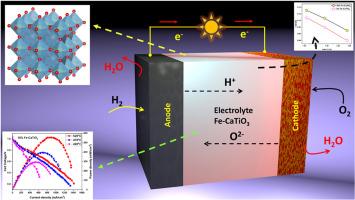表面掺杂Fe对CaTiO3作为LT-CFCs电解液的电化学性能研究
IF 5.6
2区 材料科学
Q1 MATERIALS SCIENCE, CERAMICS
引用次数: 0
摘要
陶瓷燃料电池(cfc)在低温下实现高离子电导率同时保持稳定的电化学性能仍然是一个挑战。本文研究了铁表面掺杂(表面改性)对CaTiO3 (CTO)作为低温陶瓷燃料电池电解质的影响。铁的掺入建立了一个独特的表面电荷区,通过创造离子传输途径和通过固有电场增强离子传输来促进离子运动。这导致晶格无序,电荷再分配改善离子传导,降低电子传导。此外,表面修饰促进了富氧空位的表面层,提高了电荷传输效率。x射线光电子能谱(XPS)分析证实,由于铁的掺入,氧空位显著增加。此外,扫描电镜(SEM)和高分辨率透射电镜(HR-TEM)观察表明,该材料结构一致,铁掺杂分布均匀,晶格像差明显,有利于方便快速的电荷传输。此外,表面fe掺杂的CaTiO3在520℃时表现出0.13 S/cm的高离子电导率和555 mW/cm2的合理功率密度。此外,电子顺磁共振(EPR)结果表明,表面掺杂Fe的CaTiO3产生了明显的氧空位,密度泛函理论(DFT)计算表明,CaTiO3具有低氧形成能(3.8 eV)的优化结构。这些发现表明,在CaTiO3表面掺杂铁可以产生连续的离子传输途径,为开发高性能低温陶瓷燃料电池电解质提供了一种新的途径。本文章由计算机程序翻译,如有差异,请以英文原文为准。

Electrochemical performance of CaTiO3 via surface doping of Fe as an electrolyte for LT-CFCs
Achieving high ionic conductivity at low temperatures while maintaining stable electrochemical performance in ceramic fuel cells (CFCs) remains challenging. This study investigates the effects of iron surface doping (surface modification) on CaTiO3 (CTO) as an electrolyte for low-temperature ceramic fuel cells. The incorporation of iron establishes a distinct surface charge region, facilitating ion movement by creating ion transport pathways and enhancing ion transport via an inherent electric field. This induces lattice disorder, and charge redistribution improves ion conduction and reduces electron conduction. Additionally, surface modification promotes an oxygen-vacancy-rich surface layer, improving charge transport efficiency.
X-ray photoelectron spectroscopy (XPS) analysis confirms a significant increase in oxygen vacancies due to iron incorporation. Furthermore, scanning electron microscopy (SEM) and high-resolution transmission electron microscopy (HR-TEM) observations reveal a consistent structure with evenly distributed iron doping and noticeable lattice aberrations, which are beneficial for easy and quick charge transportation. Also, the Surface Fe-doped CaTiO3 exhibits a high ionic conductivity of 0.13 S/cm and a reasonable power density of 555 mW/cm2 at 520 °C. Besides, Electron Paramagnetic resonance (EPR) results reveal that surface doping of Fe into CaTiO3 generates significant oxygen vacancies, while density functional theory (DFT) calculations demonstrate an optimized structure with a low oxygen formation energy of 3.8 eV. These findings suggest that surface doping of iron on CaTiO3 generates continuous ion transport pathways, presenting a novel approach for developing high-performance electrolytes in advanced low-temperature ceramic fuel cells.
求助全文
通过发布文献求助,成功后即可免费获取论文全文。
去求助
来源期刊

Ceramics International
工程技术-材料科学:硅酸盐
CiteScore
9.40
自引率
15.40%
发文量
4558
审稿时长
25 days
期刊介绍:
Ceramics International covers the science of advanced ceramic materials. The journal encourages contributions that demonstrate how an understanding of the basic chemical and physical phenomena may direct materials design and stimulate ideas for new or improved processing techniques, in order to obtain materials with desired structural features and properties.
Ceramics International covers oxide and non-oxide ceramics, functional glasses, glass ceramics, amorphous inorganic non-metallic materials (and their combinations with metal and organic materials), in the form of particulates, dense or porous bodies, thin/thick films and laminated, graded and composite structures. Process related topics such as ceramic-ceramic joints or joining ceramics with dissimilar materials, as well as surface finishing and conditioning are also covered. Besides traditional processing techniques, manufacturing routes of interest include innovative procedures benefiting from externally applied stresses, electromagnetic fields and energetic beams, as well as top-down and self-assembly nanotechnology approaches. In addition, the journal welcomes submissions on bio-inspired and bio-enabled materials designs, experimentally validated multi scale modelling and simulation for materials design, and the use of the most advanced chemical and physical characterization techniques of structure, properties and behaviour.
Technologically relevant low-dimensional systems are a particular focus of Ceramics International. These include 0, 1 and 2-D nanomaterials (also covering CNTs, graphene and related materials, and diamond-like carbons), their nanocomposites, as well as nano-hybrids and hierarchical multifunctional nanostructures that might integrate molecular, biological and electronic components.
 求助内容:
求助内容: 应助结果提醒方式:
应助结果提醒方式:


